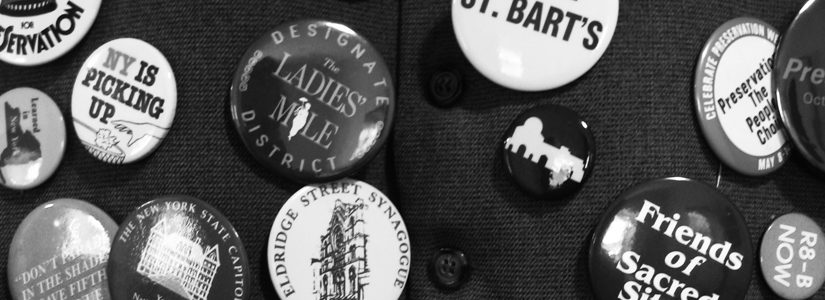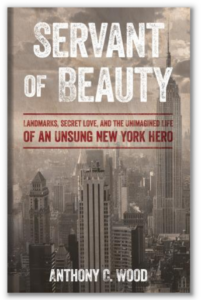
Be Your Own Preservation Archivist!
June 14, 2013 | by Anthony C. Wood, Founder & Chair
Article from the Fall 2013 Newsletter
We all have memories of those seismic historical events that have touched our lives. “What were you doing when you heard that President Kennedy had been shot?” or, more pertinent for younger generations, “Where were you on 9/11?” Those events are indelibly etched on the national consciousness and on our own. It is true that our personal memories add to the richness of that shared history, but in most cases our stories are not essential to establish the “historic record.” The opposite is true when it comes to capturing the history of preservation in New York City.
You and I have singular roles to play in documenting the history of preservation. If you’ve been involved in a preservation effort—whether fighting to save a building, restoring a historic resource, achieving designation for an historic district, or battling an ill-conceived project—your memories and records can provide singular insights into that episode of preservation’s history. You may have special knowledge that will be lost forever if not somehow “downloaded” for the future.
This was underscored to me over a recent lunch conversation with Margot Wellington, former Executive Director of the Municipal Art Society. We were discussing the “sliver” building outbreak in Manhattan in the early 1980s and the resulting successful campaign to control them. Margot recounted that a City planning staffer had told her that the reason those narrow towers had started to pop up was an “innocent” change in mandated parking requirements for new residential construction. How long would it have taken a researcher to connect those dots, let alone gain the other insights Margot and her civic colleagues could provide into that chapter of civic history?
From your work in the preservation trenches, you too have “insider” knowledge. “You were there” when preservation history was made. You were part of that delegation that met with the staff of the Landmarks Preservation Commission. You sat in on the meeting with your local elected officials. You witnessed the community board debate on that issue. You participated in the meeting with The New York Times editorial board. You were in the room when the deal was made. You worked for that agency, that politician, that non-profit, that developer; you served on that community board.
Years ago, following a NYPAP program, I received a note from the planner and community activist, the late Walter Thabit. In it he revealed the important yet almost invisible role Raymond Rubinow, long-time civic activist and “philanthropoid” extraordinaire, played in opposing the demolition of Pennsylvania Station. Thabit credited Ray with recruiting dozens to the cause and helping structure AGBANY—Action Group For Better Architecture—and “leaving the architects and other high visibility supporters the run of the effort to stop the demolition.” The role of this civic veteran in an effort frequently depicted as fueled by young architects offers us a more nuanced appreciation of the dynamics of that effort. Without Walter’s note, how would we ever know?
In addition to the specialized information stored between your ears, imagine what historians could learn from the papers stuffed in your file drawers, piled in the back of that closet, or perhaps stored in that extra shower stall? Your clipping files probably don’t contain unique information, but your correspondence and working papers certainly do! Did you keep notes of the organizing meetings of a preservation campaign? Did you head up a working committee? Do you have the list of the delegation that met with the borough president on that issue?
Even simple records, where little else exists, can provide an invaluable window into the past. Again, an example from the Pennsylvania Station story: thanks to the papers of Costas Machlouzarides, the treasurer for AGBANY, we have a partial list of those who contributed financially to AGBANY. Since AGBANY’s flame burned brightly yet briefly, and its efforts were appreciated more after the fact than at the time, having factual information about its supporters and its finances is a real gift to historians. From this simple financial document we learn that as of the date of its preparation, Philip Johnson Associates, Frances H. Jones and Alfred A Knopf were AGBANY’s largest donors, each at $100.
And what about preservation ephemera? Who doesn’t have preservation memorabilia kicking around the house? How many “Save the [fill in the blank] buttons” are in your collection? Do you still have preservation campaign T-shirts, posters, hats, you name it? In some future exhibition the history of preservation can be brought alive by these items as well as by the brick you salvaged from that landmark we lost, that piece of decorative molding you snatched from the gutted interior of the Biltmore Hotel, or a salvaged piece of terra cotta retrieved from the dumpster.
The Archive Project has been working with preservationists to both capture their memories and preserve their papers and preservation ephemera. However, to paraphrase a line from an old R&B song, “So many preservationists, so little time.” The only way to truly capture the inspiring and instructive history of preservation efforts in New York is for you to unleash the archivist within. Become your own archivist.
Thanks to the technology that has engulfed our lives, it is easier than ever to become your own archivist. You can begin by capturing some of your choice insider preservation recollections using the voice memo feature on your phone. You can now easily scan your most important preservation papers and give them a new digital life. Preservation organizations, even if all volunteer, can now document their current advocacy efforts with a click of the camera built into their phone. On that i-pad, keep notes and observations of the meetings and events you attend.
To capture the history preservationists are making every day, preservationists merely need to be conscious of the fact they are making history. The preservation history you make today can only inspire and instruct future generations of preservationists if it is documented for the future. Here at the Archive Project we are doing our best but to truly capture the old and new chapters in preservation’s evolving story, it really is up to you! Do activate your inner archivist and go to work!




